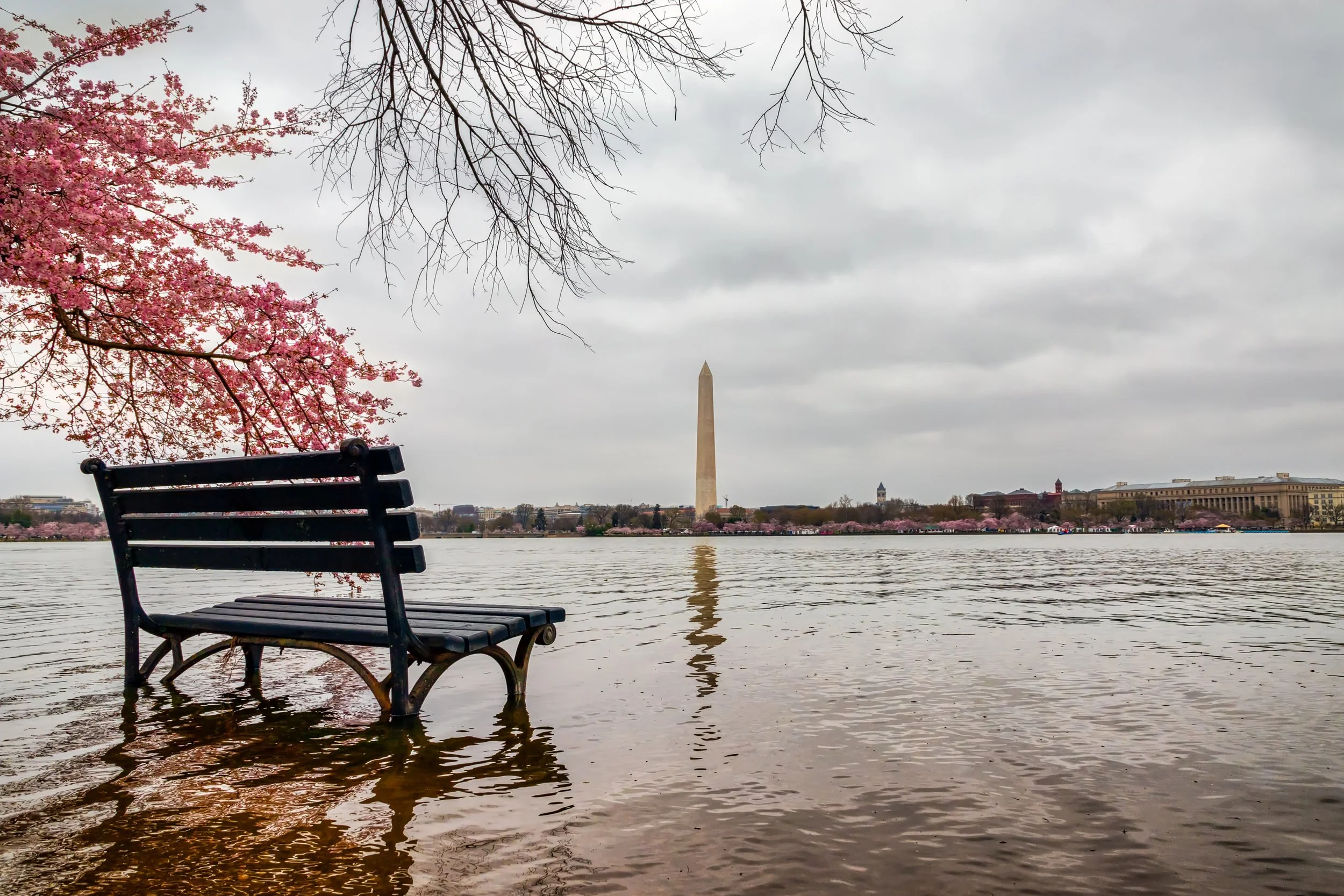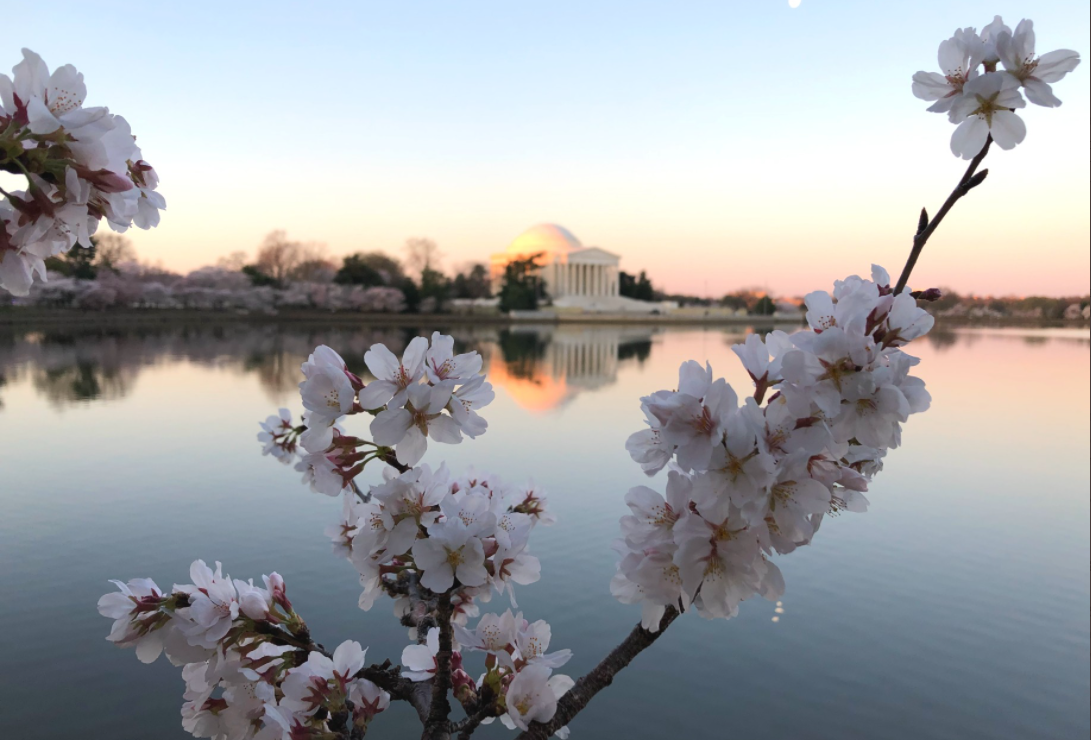Save the Tidal Basin
The Ideas Lab:
Re-Imagining the Tidal Basin
The National Mall Tidal Basin is an extraordinary public space that plays an important role in crafting the collective memory and legacy of United States history. As part of “America’s front yard,” it is home to some of the most iconic landmarks and traditions in the nation’s capital, including memorials to Thomas Jefferson, Franklin Delano Roosevelt, and Martin Luther King, Jr., as well as the beloved cherry trees.
This cherished and deeply symbolic place is at a pivotal moment, as subsidence, daily flooding, increasing visitation, and crumbling infrastructure threaten its long-term sustainability. To ensure the National Mall Tidal Basin can meet the demands of a changing landscape, the public, and modern safety and accessibility needs, we need a bold, creative, and integrated approach respectful of the symbolism and history of this significant place.
In April 2019, the National Trust for Historic Preservation announced it was naming the Tidal Basin to its portfolio of National Treasures, publicly signaling its partnership with the Trust for the National Mall, the National Park Service, and American Express to mobilize the public and marshal new resources to “Save the Tidal Basin.” The National Treasure program is the National Trust for Historic Preservation’s signature advocacy program for recognizing places of national significance in need of a long-term preservation solution. This joint effort capitalizes upon the Trust for the National Mall’s deep technical knowledge and experience in advocating for the site, the National Park Service’s stewardship role, and the National Trust for Historic Preservation’s broad preservation and community outreach expertise.
The first phase of the three-year National Treasure initiative will be to design, host, and share results from an Ideas Lab presented by American Express—a forum for generating a bold, ambitious, and integrated vision for the Tidal Basin.
The National Mall Tidal Basin Ideas Lab, presented by American Express, will invite several architectural and landscape design firms to contribute big, new ideas for re-imagining the Tidal Basin and to propose solutions to five challenges specific to the Tidal Basin site: security, circulation, hydrology, cultural landscape, and visitor experience. These proposals will then be vetted by a wide range of federal and private entities and the general public at a museum exhibition. This work will inform the National Park Service’s mandated environmental review, master planning, and detailed design processes that will follow.
Unlike a Design Competition, which typically selects a winner with a conclusive master plan, the Ideas Lab is a platform for the exchange of solutions and approaches between designers, stakeholders, and the public. It is a critical first phase in a multi-phase process to precede and supplement the National Park Service’s mandated environmental review, master planning, and detailed design.
Results of the Ideas Lab, intended to inform and engage the public in the National Park Service’s stewardship of the Tidal Basin, will be on view at a curated exhibition in Washington, D.C. in spring 2020 and available widely on a dedicated website. The results will showcase creative collaboration and design opportunities relevant for the Tidal Basin today and for generations to come.
About the Tidal Basin
The National Mall Tidal Basin sits in America’s front yard and comprises beloved national monuments such as the Jefferson Memorial, Franklin Delano Roosevelt Memorial and the Martin Luther King, Jr. Memorial. This complex, iconic public landscape’s architecture and open space captures individuals and events that have defined our nation and celebrates cherished American values. The iconic National Mall cherry trees that encircle the basin also bring 1.5 million visitors to the Tidal Basin annually for the National Cherry Blossom Festival in just a three-week period.
The need for the Tidal Basin arose out of a disastrous flood in 1881, which devastated the District so severely that much of the southern part of city was accessible only by boat. Flooded areas included parts of the National Mall such as the Washington Monument, White House Ellipse, and the Capitol. After the flood, the Army Corps of Engineers dredged the Potomac River and used sediment from the shipping channel to fill in the tidal wetlands that are now West and East Potomac Park. In 1887, engineers installed gates at the entrance and exit of a newly formed pond (now the Tidal Basin).
At high tide, the gates open and fill the pond with water. At low tide, the water exits into the Washington Channel, and the rush of water is designed to sweep the leftover sediment away. The Tidal Basin also uses a pumping system to keep the reflecting pool at the Lincoln Memorial full of water.
The Tidal Basin was named given the designation of “National Treasure” in 2019 by the National Trust for Historic Preservation, recognizing it as a place of national significance in need of a long term preservation solution.
Saving the Tidal Basin
The National Mall Tidal Basin is a vital part the country’s most visited national park and home to some of the most treasured monuments and traditions in the nation’s capital. The instability of the land underneath the Tidal Basin, daily flooding, and crumbling infrastructure threaten its sustainability and visitor enjoyment. The silt and water of the Potomac Flats make the Tidal Basin unstable—despite the gate system designed to protect it—and the conditions they create compromise both historic resources and visitors’ experiences. Each day at high tide, water floods the sidewalks surrounding the Tidal Basin, making them impassable for visitors and damaging the roots of the cherry trees. During inclement weather, conditions are even worse; the edge of the sidewalk is indistinguishable from the deeper waters in the basin. This flooding is expected to grow more severe in coming years as sea level rise causes increasingly high tides.
Other issues include non-compliant ADA access, perimeter and safety challenges, substandard visitor facilities, and inadequate interpretation. And all the challenges facing the Tidal Basin are compounded by chronic annual under-funding of the National Park Service maintenance budget. The NPS National Mall Plan, a 50-year vision for the nation’s most visited national park, estimates as much as $500 million in needed upgrades at the Tidal Basin and more than $800 million in total at the National Mall, constituting the largest portion of the $11.6 billion National Park System deferred maintenance backlog.










